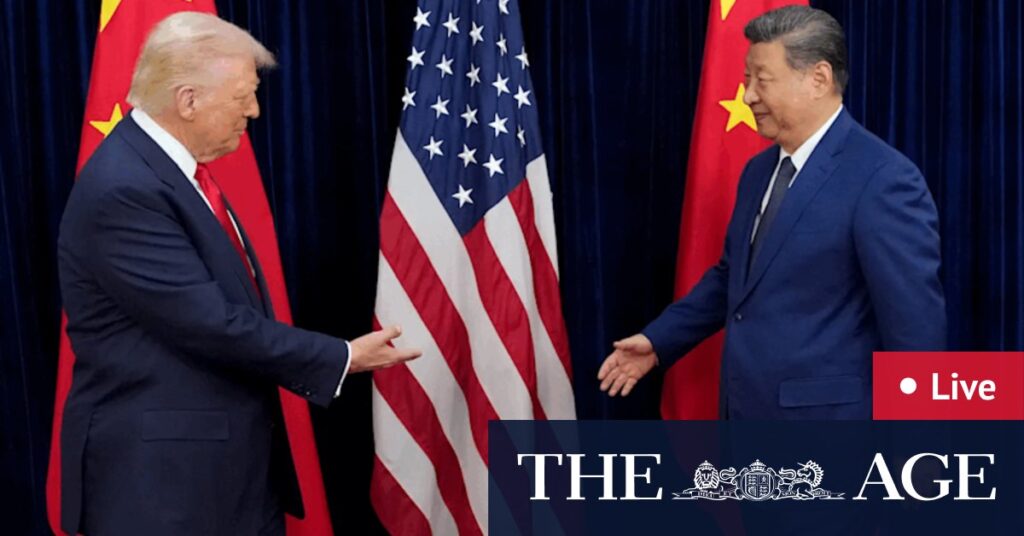
In a highly anticipated meeting in South Korea, US President Donald Trump and Chinese President Xi Jinping convened to discuss critical issues affecting the two global superpowers. The meeting, which took place on the sidelines of the Asia-Pacific Economic Cooperation (APEC) summit, focused on trade, tariffs, and the ongoing tensions over Taiwan.
The meeting comes amid heightened global attention, as just before the bilateral talks, President Trump took to Truth Social to announce his intention to resume nuclear weapons testing, a move that could overshadow the discussions. Despite this, both leaders expressed optimism about the potential for a positive relationship between their countries.
Opening Remarks and Diplomatic Exchanges
In their opening statements, President Trump lauded Xi as a “great leader” and expressed hope for a “fantastic relationship for a long period of time.” Meanwhile, President Xi acknowledged the natural frictions between the two leading economies but emphasized the importance of partnership and friendship. “I always believe that China’s development goes hand-in-hand with your vision to make America great again,” Xi stated.
The media was subsequently ushered out, and the meeting continued behind closed doors. According to Chinese state media, the discussions lasted approximately one hour and 40 minutes, concluding with no public comments from either leader before their respective departures.
Trump’s Asian Tour: A Strategic Move
President Trump’s visit to South Korea is part of a broader Asian tour aimed at strengthening trade ties and addressing regional security concerns. Prior to arriving in South Korea, Trump attended the ASEAN summit in Kuala Lumpur, Malaysia, where he signed trade and tariff agreements with Thailand and Malaysia. He also played a role in expanding a peace deal between Thailand and Cambodia, highlighting his focus on regional stability.
Following his engagements in Malaysia, Trump traveled to Japan, where he met with Prime Minister Sanae Takaichi and addressed US troops stationed there. His whirlwind tour underscores his administration’s strategic pivot towards Asia, especially in the context of rising tensions with China.
Historical Context and Ongoing Tensions
The meeting between Trump and Xi is set against a backdrop of historical tensions and recent escalations. The US-China relationship has been fraught with challenges, particularly in areas such as trade, technology, and geopolitical influence. The trade war initiated during Trump’s first term saw tariffs imposed on billions of dollars worth of goods, affecting global markets and economic growth.
Moreover, the issue of Taiwan remains a significant point of contention. While Trump did not plan to address Taiwan’s security directly in this meeting, the topic looms large over US-China relations. The strategic ambiguity surrounding Taiwan’s status continues to be a flashpoint in the broader geopolitical landscape.
Market Reactions and Expert Opinions
The anticipation of the Trump-Xi meeting had immediate effects on global markets. Chinese stocks surged to a decade high, with the Shanghai Composite Index rising as much as 0.2 percent, driven by hopes for a de-escalation in trade tensions. Investors are cautiously optimistic, though wary of the potential for a superficial agreement that may not address deeper issues.
“The proposed deal on the table fits the pattern we’ve seen all year: short-term stabilisation dressed up as strategic progress,” said Craig Singleton, a senior director of the China program at the Foundation for Defence of Democracies.
Singleton’s comments reflect a broader skepticism among analysts who view the meeting as a temporary reprieve rather than a long-term solution to the underlying rivalry between the US and China.
Looking Ahead: Implications and Future Prospects
As Trump returns to Washington, DC, to host a Halloween event at the White House, the world watches closely for any tangible outcomes from the meeting. The discussions in South Korea may set the tone for future engagements between the two nations, but significant challenges remain.
The ongoing competition for technological supremacy, particularly in areas like artificial intelligence, and the geopolitical maneuvering in regions such as the South China Sea and Eastern Europe, will continue to test the resilience of US-China relations. As both countries navigate these complex dynamics, the international community remains hopeful for a path toward cooperation and stability.






